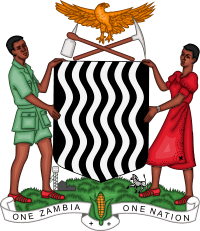Energy in Zambia
Zambia is potentially self-sufficient in sources of electricity, coal, biomass and renewable energy. The only energy source where the country is not self-sufficient is petroleum energy. Many of the sources of energy where the country is self-sufficient are largely unexploited.[1]
Overview
As of 2016, it was estimated that 28 percent of Zambia's population had access to electricity, with 62 percent of the urban population and 5 percent of the rural population having access. At that time, about 500,000 urban households and approximately 1.8 million rural households did not have access to electricity.[2] It is estimated that electricity demand in the country is growing at about 3 percent annually.[3]
There are three power producing and distribution companies in Zambia; (a) Zambia Electricity Supply Corporation Limited (ZESCO), a government-owned company (b) Lunsemfwa Hydro Power Limited and (c) Ndola Energy. ZESCO, the largest of the three owns and maintains 94.7 percent (2306/2434) of installed hydropower capacity, as of 2016.[2]
Hydroelectricity
As of 2016, the country had 2,434 megawatts (3,264,000 hp) of installed hydropower capacity, with an estimated 6,000 megawatts (8,000,000 hp) of untapped hydropower potential.[1] Hydroelectricity constitutes over 95 percent of Zambia's electricity generation pool. Several existing large hydro facilities are currently being upgraded. Some of the new large hydropower projects in the pipeline include the 2,400 megawatts Batoka Gorge Hydroelectric Power Station and the 1,000 megawatts Luapula Hydroelectric Power Station. Substantial untapped hydropower potential exists for small scale rural electrification projects.[4]
Thermal power
There are two grid-ready thermal power stations; (a) the 50 megawatts (67,000 hp) heavy fuel oil plant owned by Ndola Energy and (b) the six gas turbines with combined capacity of 80 megawatts (110,000 hp), which are owned and operated by the Copperbelt Energy Corporation.[2]
Zambia has proven coal reserves of at least 80,000,000 tonnes in the country's Southern Province. Potential reserves exist elsewhere in the county, although the size of that potential has not yet been quantified.[1]
Oil and natural gas
Although Zambia has no proven commercial deposits of oil, the country hosts an oil refinery, the Indeni Petroleum Refinery, a 24,000 barrels-a-day facility, based in Ndola, in the Copperbelt Province.[5][6]
Renewable energy
As of April 2016, the peak electricity demand outstripped peak energy production by 560 megawatts. The government, ZESCO, civil society and other stakeholders are exploring opportunities in the solar, wind, and geothermal spaces to meet the deficit and to plan for future energy needs.[7]
See also
References
- 1 2 3 Chimase, Margaret (25 May 2016). "An overview of the energy sector". Zambia Daily Mail. Lusaka. Retrieved 21 April 2018.
- 1 2 3 Africa-EU-Renewables (2016). "Zambia: Energy Sector". Africa-EU-Renewables.org. Retrieved 21 April 2018.
- ↑ Zambia Development Agency (2016). "Zambia Development Agency: Overview of Zambia's Energy Sector". Lusaka: Zambia Development Agency. Retrieved 21 April 2018.
- ↑ Africa-EU-Renewables (2016). "Zambia: Renewable Energy Potential". Africa-EU-Renewables.org. Retrieved 21 April 2018.
- ↑ Taonga Clifford Mitimingi, and Paul Burkhardt (16 March 2018). "Glencore, Vitol Bid for Stake in Zambia's Sole Oil Refinery". Bloomberg LP. Retrieved 21 April 2018.
- ↑ Chris Mfula, and James Macharia (16 April 2018). "Zambia Short-Lists Five Firms For Majority Stake In Oil Refinery". Rigzone.com Quoting Reuters. Retrieved 21 April 2018.
- ↑ Chisanga, Melony (27 April 2016). "Is renewable energy a solution to Zambia's energy deficit?". Lusaka Times. Lusaka. Retrieved 21 April 2018.
